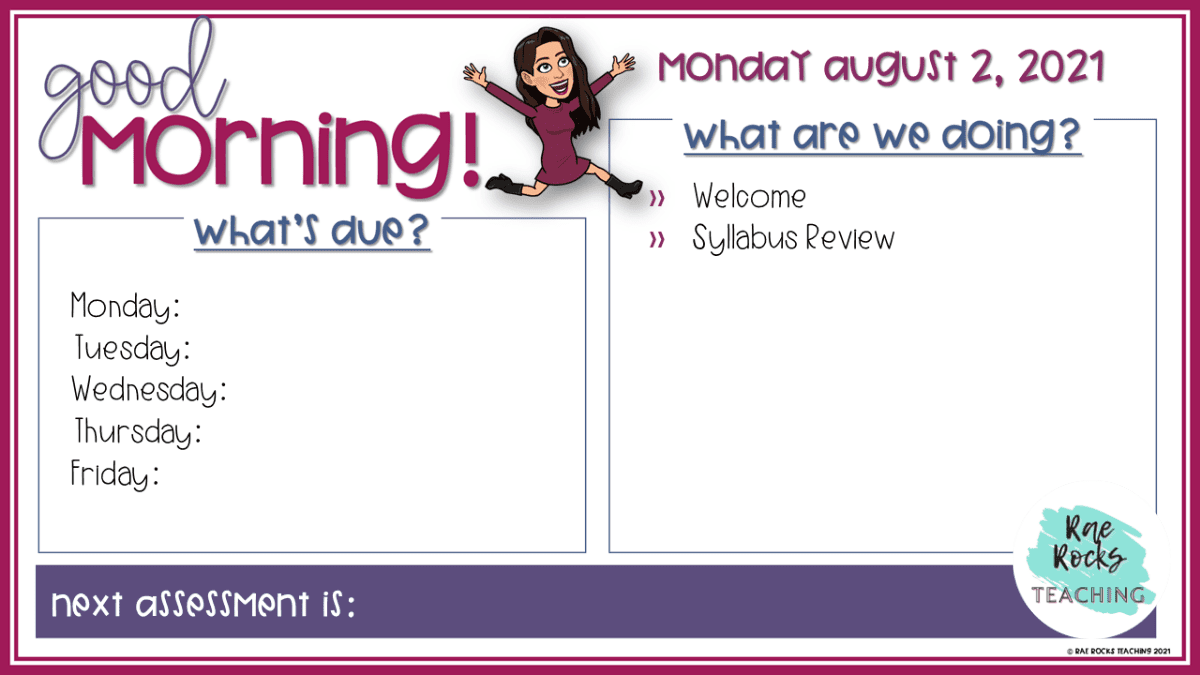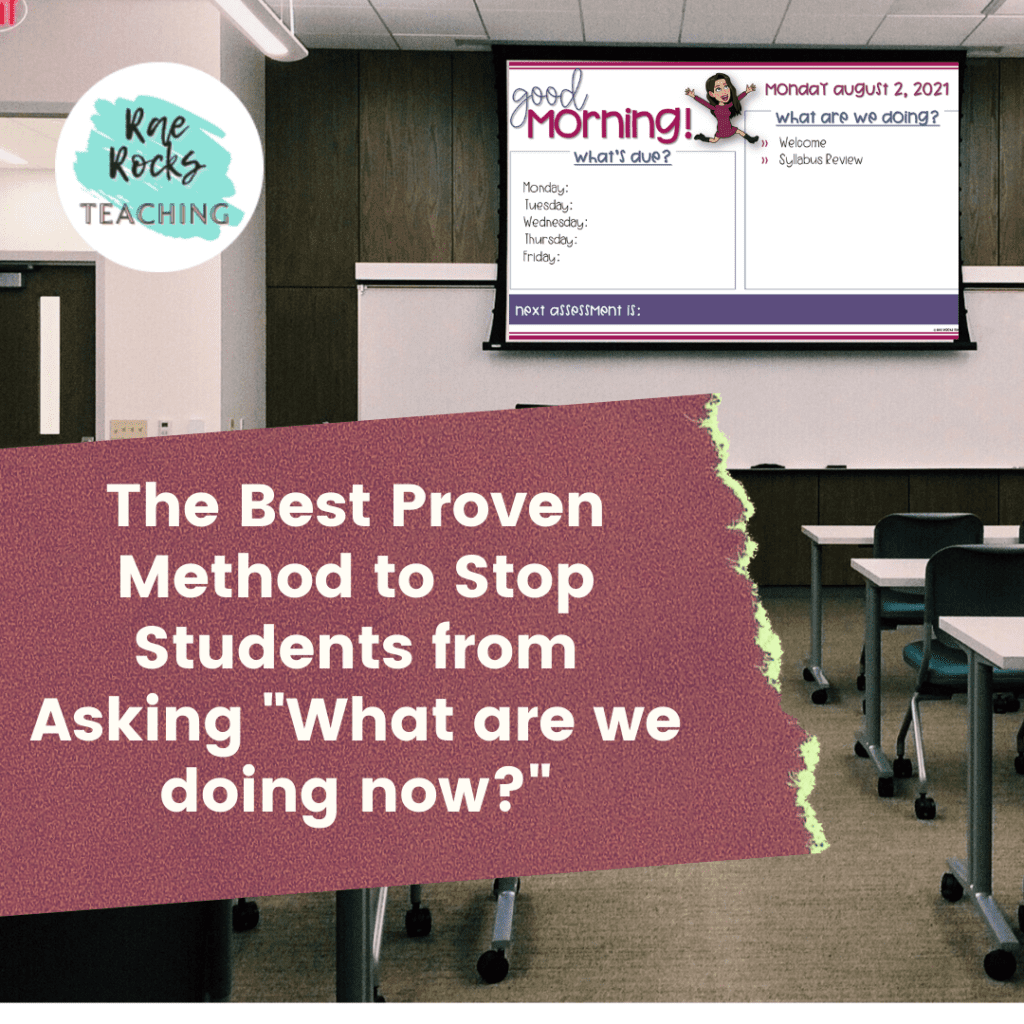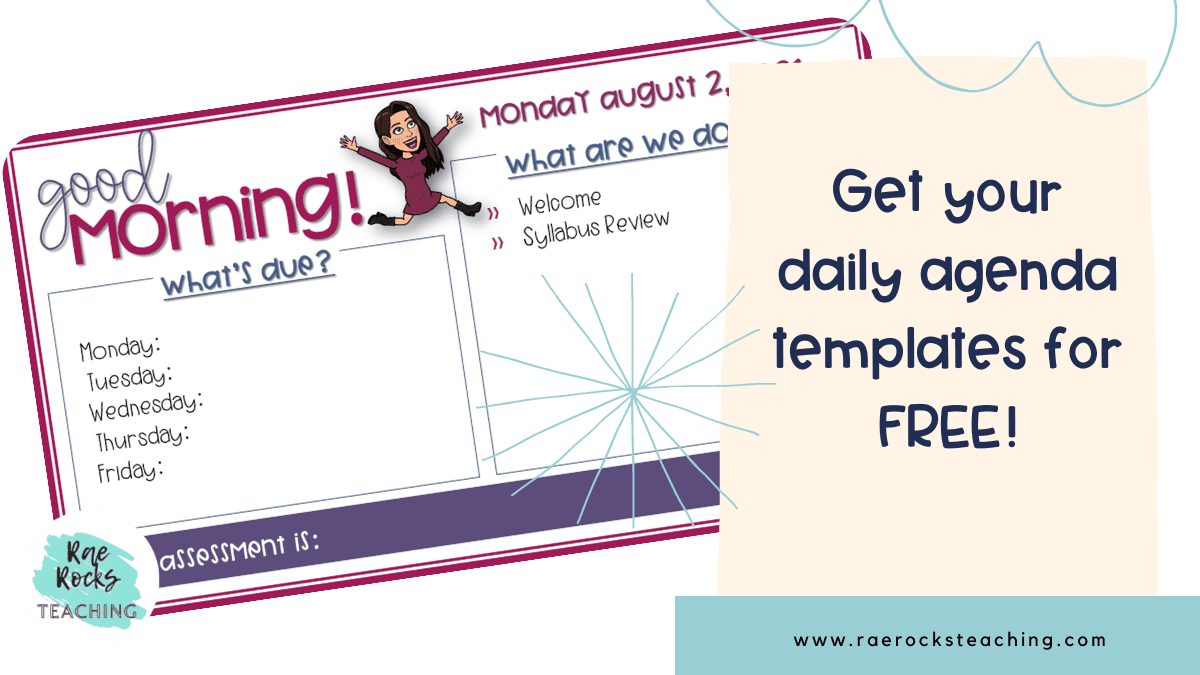Do you get annoyed by your students always asking “What are we doing now?”
“What are we doing now?” seems to be the first thing they ask when they walk into the classroom or after they have finished an assignment. I have a solution to add to your lesson planning-a Daily Agenda. Speaking of lesson planning, read about 10 Things Your Lesson Plans for Biology Need.
Why did I Start Using a Daily Agenda?
Then, one of my favorite administrators recommended that I start using a daily agenda in the classroom to project on the board so students could see what they were working on each day. At the time, I thought that he was asking a lot, but he is one of the smartest educators I know, so I took his advice. I started very basic with only the date, standard, and bulleted list of briefly what we were doing. Slowly, I started to notice that students were not hounding me as soon as they walked in the door about what are we doing today. Over the 13 years I have been teaching, my daily agenda has evolved. I try to fit as much detail there as I can fit onto the slide without making their eyes crossed. Interested in how you stop the daily interrogation? Scroll down for the answer!

-
Save
-
Save
Here are FIVE reasons that you should use a daily agenda in your classroom to eliminate the “What are we doing now?” question.
ONE | Time management
Using a daily agenda will help to keep you on schedule and save valuable learning time. If used daily, then students become accustomed to looking at the board and seeing what they should work on while you take roll. If students know what they are doing, this builds independence and eliminates them asking “What do we do now?”
TWO | Organization
By having materials that they need listed on the agenda they can come in prepared for class and have all the necessary materials they are going to use. This allows them to have everything ready so as to not waste precious instructional time fishing for materials such as glue sticks, scissors, handouts, etc.
Organization Side Note: As an organization-obsessed person, I recommend saving these (digitally) so you can refer back to them in the future to see what you did on a specific date, time, or unit.
THREE | Establishes expectations and provides a daily routine
Once you incorporate the daily agenda into your classroom, over time students will come in and automatically look at the agenda. I like to include the date, the day, any reminders or due dates of upcoming events, and the learning target students will achieve that day. By putting these on your agenda, you are allowing students to mentally prepare themselves for what is to come in the lesson. Another recommendation would be to print them out daily and attach them to your absent assignments. Or post them to an absentee bulletin board or some location digitally where students have access so they can find their assignments when they’re absent.
If you get students in the habit of checking the agenda before they return to class, they know exactly what they need to get and what they missed while they were out. If these are posted digitally or in the classroom students should be made aware of where they can find this information so that they can come to class the next day prepared.
FOUR | Reduces discipline issues
When students know what they are to work on next, it helps reduce downtime which is often when students get into trouble. Using it every day will allow students to become conditioned to reading the agenda and see what they are doing next. This eliminates confusion that often comes when students don’t know what they should be working on and do not want to ask.
I once had a student that as soon as they were finished with an assignment, wanted to get up and roam the room. This student would say “I’m done.” While I understand students need to work out of their seats at times, this was not one of those occasions. This student wandered the room and bothered others who were still working leading to constant issues with discipline. Once I established the daily agenda in my classroom, there was a visual cue right in front of them so they could see what they should start on next.
FIVE | Anyone, including admin, can come into your classroom at any time and know exactly what you are working on
Brownie points anyone? These can be displayed on any media type including PowerPoint, Google Slides, poster, or your whiteboard. Admin will always ask the kid who is paying attention the least what you are working on in class (Trust Me!) Help them out by having it posted so they can give an appropriate answer.
If you are a 1:1 class (or school) and use Google Classroom or another LMS system then you could also host these there. If you teach younger grades this would be a great way to communicate with parents about what you are doing each day as well.
Want tips for creating a stellar daily agenda? Keep reading!
Here are some tips to make your usage of the daily agenda in the classroom more effective.
💡Tip No.1:
Always put the day and date on your agenda. You would be surprised at how many students don’t know what day of the week or day of the month it is. Help these sweet angels get their life together and post the day and date.
💡Tip No. 2:
Use a classroom daily agenda template so that you do not have to recreate the wheel every single day. If you have a basic outline of things that you are going to include in your daily agenda, all you need to do is change the day, the date, and the other pertinent information. This could be activities, assignments, reminders, or upcoming dates.
💡Tip No. 3:
Be as descriptive as you can get on the slide. Now I’m not talking about paragraphs. I am referring to putting as much information on there as possible so that students know exactly what is expected of them each day of the week or month of the year. For example, if I just put “review” then they will probably ask you what kind of review are we doing? Again the goal of the daily agenda is to reduce the amount of asking “what are we doing now?” So I would recommend putting something more descriptive like Jeopardy Review Game or work on a study guide review sheet. That’s what I mean by descriptive so that students know exactly what they are doing.
Have you ever been to an event without an agenda? Did you ask people around you what you are doing? Humans by nature are inquisitive and they want to know what is happening in their world. Students are no different than adults in this aspect. I know if I go to a seminar I would like to know exactly what the speaker is talking about.
💡Tip No. 4:
This is not 100% necessary but it does create more visual interest. I like to change the agenda template each month so it represents the time of year. For example, if it is November, then I like to have fall color leaves or a Thanksgiving scene as the background. Or if it is March, I would do something with Saint Patrick’s Day. April I made do something with spring and rain or flowers. This keeps it from being monotonous and for them seeing the same slide over and over again because teenagers tend to tune things out when they get bored. By switching it up from time to time you keep them interested.

-
Save

-
Save
💡Tip No. 5:
Get into the habit of pointing to the agenda if they ask you what we are doing now. Eventually, they will get the hint. I had a kid in my class that would ask me every day what we were doing. I never responded to him except by pointing to the board. After about a week, he realized that I’m not going to give a rundown of what we’re doing in class. He started to just come in and check the board and not ask me anymore.
So Now What?
I am not saying that using a daily agenda will eliminate all problems in the classroom like a magic wand. I am saying it will help tremendously in many aspects of your classroom. Want more help with lesson planning? Don’t forget to grab my free lesson planning template to help simplify that area of your teaching as well.
I absolutely love sharing with y’all and would love to connect on IG or Facebook. Follow me and send me a DM with what you need more of because I’m here to help! After incorporating a daily agenda into your classroom, comment below and let me know how it went.
If you would you like a copy of this Classroom Daily Agenda Template for FREE, fill out the form below!
Related Articles:
Why You Need A Daily Agenda Slide for Your Classroom
Daily Agendas: The Key to Organizing the Classroom
How to Get Organized with Daily Agendas in Google Slides

-
Save
Share via:










2 Responses